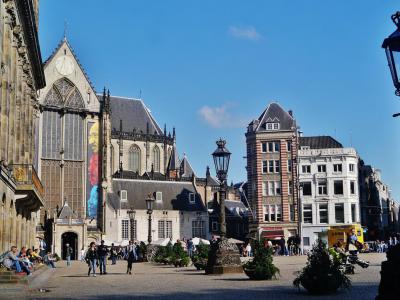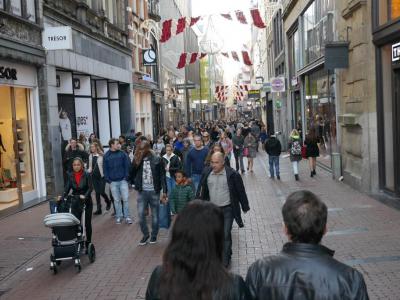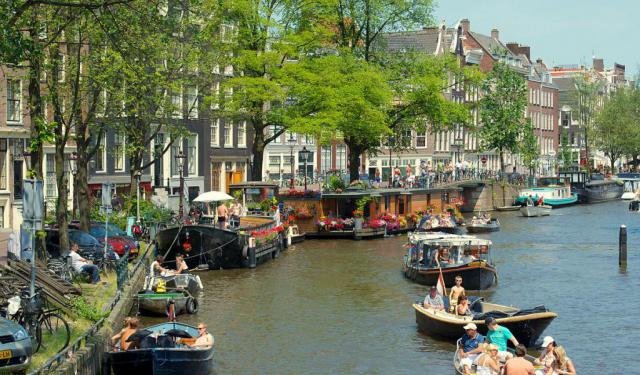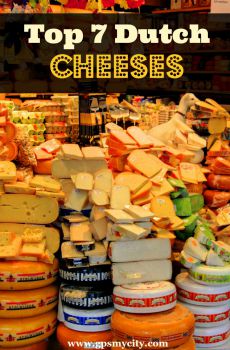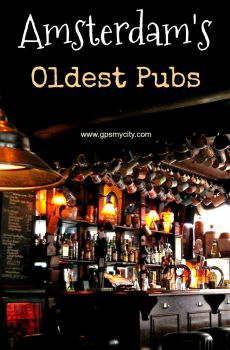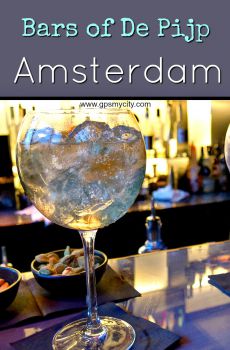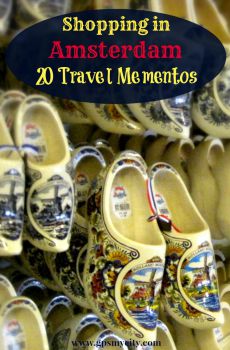
City Center Walking Tour (Self Guided), Amsterdam
The inner-most borough and historic heart of Amsterdam, known locally as Centrum, is a tightly woven network of canals and overlapping micro-neighborhoods, each bursting with their own unique vibe and history. Formerly a working-class area, this district is reputed for its traditional community spirit, radical politics and historic brown bars.
Here, all within an easy walking distance you will find lively canal-side terraces packed to the brim with restaurants and bars, vintage shops and quirky, world-class museums, renowned cultural attractions and other notable buildings dotted around the charming, leafy cobbled streets, high-end shopping areas, and sprawling market squares.
Walking from the Central Station, Amsterdam's main public transport hub, you will soon find yourself at Dam Square – dominated by the neoclassical Royal Palace and 14th-century Gothic Nieuwe Kerk (New Church). Venturing further into the tightly clustered area you encounter more prominent sights, like Madame Tussaud's and the National Monument (an iconic World War II memorial) before ending on Kalverstraat – one of the most popular thoroughfares in Amsterdam, lined with flagship stores, restaurants and world-famous entertainment venues.
Beyond the best known attractions, there's also a treasure trove of hidden gems just waiting to be discovered, like Begijnhof – one of the oldest local hofjes (hidden courtyards).
If you're keen to “unearth” these and other cultural treasures in the historic center of Amsterdam, in your good time and at your own pace, take this self-guided walking tour.
Here, all within an easy walking distance you will find lively canal-side terraces packed to the brim with restaurants and bars, vintage shops and quirky, world-class museums, renowned cultural attractions and other notable buildings dotted around the charming, leafy cobbled streets, high-end shopping areas, and sprawling market squares.
Walking from the Central Station, Amsterdam's main public transport hub, you will soon find yourself at Dam Square – dominated by the neoclassical Royal Palace and 14th-century Gothic Nieuwe Kerk (New Church). Venturing further into the tightly clustered area you encounter more prominent sights, like Madame Tussaud's and the National Monument (an iconic World War II memorial) before ending on Kalverstraat – one of the most popular thoroughfares in Amsterdam, lined with flagship stores, restaurants and world-famous entertainment venues.
Beyond the best known attractions, there's also a treasure trove of hidden gems just waiting to be discovered, like Begijnhof – one of the oldest local hofjes (hidden courtyards).
If you're keen to “unearth” these and other cultural treasures in the historic center of Amsterdam, in your good time and at your own pace, take this self-guided walking tour.
How it works: Download the app "GPSmyCity: Walks in 1K+ Cities" from Apple App Store or Google Play Store to your mobile phone or tablet. The app turns your mobile device into a personal tour guide and its built-in GPS navigation functions guide you from one tour stop to next. The app works offline, so no data plan is needed when traveling abroad.
City Center Walking Tour Map
Guide Name: City Center Walking Tour
Guide Location: Netherlands » Amsterdam (See other walking tours in Amsterdam)
Guide Type: Self-guided Walking Tour (Sightseeing)
# of Attractions: 11
Tour Duration: 2 Hour(s)
Travel Distance: 2.3 Km or 1.4 Miles
Author: clare
Sight(s) Featured in This Guide:
Guide Location: Netherlands » Amsterdam (See other walking tours in Amsterdam)
Guide Type: Self-guided Walking Tour (Sightseeing)
# of Attractions: 11
Tour Duration: 2 Hour(s)
Travel Distance: 2.3 Km or 1.4 Miles
Author: clare
Sight(s) Featured in This Guide:
- Centraal Station
- Sexmuseum / Temple of Venus
- Beurs van Berlage (Old Stock Exchange)
- Dam Square
- National Monument on Dam Square
- Madame Tussauds
- Koninklijk Paleis (Royal Palace of Amsterdam)
- Nieuwe Kerk (New Church)
- Magna Plaza
- Begijnhof – Beguine Courtyard
- Kalverstraat
1) Centraal Station (must see)
During your time in Amsterdam, a visit to the Centraal Station is practically inevitable, as it stands as a pivotal transportation hub that nearly every traveler encounters at least once. With its distinctive high gables, cheerful brickwork, and the arrival of over 1,500 trains, this station ranks among the busiest, catering to nearly 250,000 commuters each day. In essence, it serves as the true heart of Amsterdam!
Centraal Station commenced its service at the close of the 19th century, an architectural testament designed by the skilled hands of P.J.H. Cuypers and A.L. van Gendt. It symbolized the resurgence of the nation's once-struggling economy. Interestingly, it was constructed upon three artificial islands, its current location differing from the initial choice. To anchor such a monumental edifice on the marshy ground, a precise total of 8,687 wooden piles were employed as foundational support. The entire endeavor appeared fraught with challenges and was swiftly criticized by numerous experts. However, the architects persevered, ultimately vindicating themselves and defying skeptics.
Today, this Neo-Renaissance edifice majestically graces the banks of the IJ River, captivating onlookers with its imposing presence and the engineering marvel that brought it to fruition.
Why You Should Visit:
Seamlessly blends historic neo-Renaissance architecture with cutting-edge technology, serving as both a bustling mass transit hub and a symbol of cosmopolitan vibrancy.
Tip:
Take advantage of the several free ferry trips navigating the canals, departing every 5 or 15 minutes from this location; they offer a rewarding experience. You can even cruise back to the station via boat if you wish, rounding out your visit with a picturesque waterborne journey.
Centraal Station commenced its service at the close of the 19th century, an architectural testament designed by the skilled hands of P.J.H. Cuypers and A.L. van Gendt. It symbolized the resurgence of the nation's once-struggling economy. Interestingly, it was constructed upon three artificial islands, its current location differing from the initial choice. To anchor such a monumental edifice on the marshy ground, a precise total of 8,687 wooden piles were employed as foundational support. The entire endeavor appeared fraught with challenges and was swiftly criticized by numerous experts. However, the architects persevered, ultimately vindicating themselves and defying skeptics.
Today, this Neo-Renaissance edifice majestically graces the banks of the IJ River, captivating onlookers with its imposing presence and the engineering marvel that brought it to fruition.
Why You Should Visit:
Seamlessly blends historic neo-Renaissance architecture with cutting-edge technology, serving as both a bustling mass transit hub and a symbol of cosmopolitan vibrancy.
Tip:
Take advantage of the several free ferry trips navigating the canals, departing every 5 or 15 minutes from this location; they offer a rewarding experience. You can even cruise back to the station via boat if you wish, rounding out your visit with a picturesque waterborne journey.
2) Sexmuseum / Temple of Venus
What began with skepticism has evolved into one of Amsterdam's standout attractions today. Amidst its rich history, stunning art, and breathtaking architecture, the city boasts an exuberant sex and erotic industry, and proudly houses the world's inaugural Sexmuseum. Established in 1985, this museum draws an annual average of over 500,000 visitors, undoubtedly piquing curiosity about the historical facets of humanity's carnal desires. (Who wouldn't find that intriguing?)
However, it's essential to clarify that this museum isn't suitable for everyone and is strictly intended for adults, not children. Its galleries are replete with paintings, sculptures, vintage photographs, cartoons, and various media, all united by the theme of erotica and sensuality. Furthermore, it boasts an extensive collection of artifacts, personal possessions, and records belonging to historical figures who played significant roles in shaping and influencing the history of sexuality, including Marquise de Pompadour, Marquis de Sade, and Mata Hari, among others. An entertaining section of the museum is dedicated to exploring the practices of the ancient Greeks and Romans in this context, with every sexual deviation revealed in various displays.
In its entirety, the Sexmuseum offers a fun and informative experience that shouldn't be overlooked.
However, it's essential to clarify that this museum isn't suitable for everyone and is strictly intended for adults, not children. Its galleries are replete with paintings, sculptures, vintage photographs, cartoons, and various media, all united by the theme of erotica and sensuality. Furthermore, it boasts an extensive collection of artifacts, personal possessions, and records belonging to historical figures who played significant roles in shaping and influencing the history of sexuality, including Marquise de Pompadour, Marquis de Sade, and Mata Hari, among others. An entertaining section of the museum is dedicated to exploring the practices of the ancient Greeks and Romans in this context, with every sexual deviation revealed in various displays.
In its entirety, the Sexmuseum offers a fun and informative experience that shouldn't be overlooked.
3) Beurs van Berlage (Old Stock Exchange)
The grandeur of the Beurs, the historic Stock Exchange, famously known as the "Beurs van Berlage," designed by the prominent figure in Dutch Modern architecture, Hendrik Petrus Berlage at the turn of the 20th century, holds great fascination for those interested in city architecture. Berlage's creation marked a significant departure from the 19th-century historicism championed by Cuypers, opting instead for a style characterized by cleaner, more substantial lines influenced by Romanesque and Renaissance elements, while minimizing ornate details. This visionary approach foreshadowed the Expressionist movement that swept through northern Europe from 1905 to 1925, leaving a lasting impact. Considered ahead of its time, Berlage's designs stand out distinctly in Amsterdam's skyline.
Although the Beurs no longer serves its original commercial purpose, it has evolved into a venue for concerts, conferences, and exhibitions showcasing modern art and design. Nevertheless, the building itself remains the star attraction, notably featuring graceful shallow-arched arcades and intricate brickwork in the main hall.
Tip:
For those not inclined to opt for a guided tour, Berlage's architectural contributions can still be admired in the welcoming Bistro Berlage at the southern end of the building, adjacent to Beursplein, or at the Tony's Chocolonely Super Store (Oudebrugsteeg 15), where excellent dark chocolates are also on offer.
Although the Beurs no longer serves its original commercial purpose, it has evolved into a venue for concerts, conferences, and exhibitions showcasing modern art and design. Nevertheless, the building itself remains the star attraction, notably featuring graceful shallow-arched arcades and intricate brickwork in the main hall.
Tip:
For those not inclined to opt for a guided tour, Berlage's architectural contributions can still be admired in the welcoming Bistro Berlage at the southern end of the building, adjacent to Beursplein, or at the Tony's Chocolonely Super Store (Oudebrugsteeg 15), where excellent dark chocolates are also on offer.
4) Dam Square (must see)
Positioned at the very core of the city, Dam Square, commonly referred to as the Dam, holds historical significance as the place that bestowed Amsterdam with its name. In the 13th century, the River Amstel was dammed here, giving rise to the fishing village that eventually earned the name "Amstelredam". Boats traversed Damrak to access the square, unloading goods in the heart of the burgeoning village, which thrived through the exchange of herring for Baltic grain. Subsequently, the construction of Amsterdam's principal church, the Nieuwe Kerk, and later the town hall ("Koninklijk Paleis"), solidified the Dam's status as Amsterdam's focal point.
Today, it stands as an open and spacious area, despite the prominent presence of the primary municipal war memorial. This memorial features a prominent stone obelisk adorned with somber figures and embellished with the coats of arms representing each of the Netherlands' provinces, including the former colony of Indonesia. The square otherwise primarily serves as a venue for large-scale events, such as National Tulip Day, when the entire space blooms with tulips. While it may not demand an extensive visit, it serves as a valuable reference point for navigating the city.
Why You Should Visit:
An ideal setting to immerse oneself in the city's vibrant atmosphere, explore diverse culinary options, peruse shops, revel in music, or simply relax by the fountain.
Tip:
For those in need of restroom facilities, free and well-maintained toilets are available at the De Buenkork shop on the 5th floor.
Today, it stands as an open and spacious area, despite the prominent presence of the primary municipal war memorial. This memorial features a prominent stone obelisk adorned with somber figures and embellished with the coats of arms representing each of the Netherlands' provinces, including the former colony of Indonesia. The square otherwise primarily serves as a venue for large-scale events, such as National Tulip Day, when the entire space blooms with tulips. While it may not demand an extensive visit, it serves as a valuable reference point for navigating the city.
Why You Should Visit:
An ideal setting to immerse oneself in the city's vibrant atmosphere, explore diverse culinary options, peruse shops, revel in music, or simply relax by the fountain.
Tip:
For those in need of restroom facilities, free and well-maintained toilets are available at the De Buenkork shop on the 5th floor.
5) National Monument on Dam Square
Crafted by the renowned Dutch architect Jacobus Oud, Dam Square proudly hosts a 22-meter (70-foot) tall obelisk, serving as a poignant memorial to the Second World War. Behind this solemn monument, urns hold soil collected from cemeteries and execution sites. The structure has become a national symbol, where each year, on May 4th, the Remembrance of the Dead ceremony takes place.
While this obelisk garners attention from numerous visitors, only a select few truly grasp its intricate symbolism. Adorned with exquisite details arranged in concentric circles, the obelisk features sculptures depicting men, howling dogs, and birds. On the front side, two male figures symbolize the Dutch Resistance Movement, while the left and right sides represent intellectuals and the working class, respectively. Dogs are emblematic of loyalty and suffering, while a woman with a child represents victory, peace, and new beginnings. Meanwhile, doves ascending to the skies symbolize freedom and liberation.
Why You Should Explore:
One of the most important European symbols that recall the immense tragedy of the Second World War. A tranquil spot for a brief pause while you explore other attractions in the vicinity.
While this obelisk garners attention from numerous visitors, only a select few truly grasp its intricate symbolism. Adorned with exquisite details arranged in concentric circles, the obelisk features sculptures depicting men, howling dogs, and birds. On the front side, two male figures symbolize the Dutch Resistance Movement, while the left and right sides represent intellectuals and the working class, respectively. Dogs are emblematic of loyalty and suffering, while a woman with a child represents victory, peace, and new beginnings. Meanwhile, doves ascending to the skies symbolize freedom and liberation.
Why You Should Explore:
One of the most important European symbols that recall the immense tragedy of the Second World War. A tranquil spot for a brief pause while you explore other attractions in the vicinity.
6) Madame Tussauds
Why not go beyond exploring the exceptional creations of renowned figures from Dutch history on display in numerous museums in and around Amsterdam and instead treat yourself to the one-of-a-kind opportunity to meet lifelike wax replicas of these iconic personalities? This intriguing experience is precisely what draws visitors from around the world to Madame Tussauds.
The museum's space is teeming with life-sized wax figures, encompassing artists, craftsmen, and renowned personalities from the Dutch Golden Era. Amid the array of past luminaries, the museum's true highlights are the multitude of international figures, spanning contemporary movie stars, politicians, members of royal families, and many others. Exhibits range from the utterly fascinating to the delightfully eccentric. Enhanced by special effects, including animatronics, these displays vividly bring scenes from Holland's past to life.
With each passing year, Madame Tussauds' wax models bear an even more striking resemblance to their real-life counterparts. The museum's primary aim is to offer every visitor the chance to capture a moment with their favorite celebrity, whether from the present or the past. Additionally, family and joint tickets are available in conjunction with the Amsterdam Dungeon.
Tip:
Don't miss the opportunity to ascend to the top floor, where you'll be treated to a magnificent view of Dam Square!
The museum's space is teeming with life-sized wax figures, encompassing artists, craftsmen, and renowned personalities from the Dutch Golden Era. Amid the array of past luminaries, the museum's true highlights are the multitude of international figures, spanning contemporary movie stars, politicians, members of royal families, and many others. Exhibits range from the utterly fascinating to the delightfully eccentric. Enhanced by special effects, including animatronics, these displays vividly bring scenes from Holland's past to life.
With each passing year, Madame Tussauds' wax models bear an even more striking resemblance to their real-life counterparts. The museum's primary aim is to offer every visitor the chance to capture a moment with their favorite celebrity, whether from the present or the past. Additionally, family and joint tickets are available in conjunction with the Amsterdam Dungeon.
Tip:
Don't miss the opportunity to ascend to the top floor, where you'll be treated to a magnificent view of Dam Square!
7) Koninklijk Paleis (Royal Palace of Amsterdam) (must see)
The Royal Palace, positioned on the western side of Dam Square, stands as the city's most impressive edifice, a commanding sandstone structure erected during a time when Amsterdam held peak prominence and was asserting its municipal strength. Constructed in the mid-17th century, Amsterdam was then a leading Dutch town that had recently thwarted William of Orange's attempts to subdue it. Inevitably, the city council sought a residence that would symbolize Amsterdam's municipal authority and pride, leading them to embrace a remarkably forward-thinking design—a Dutch interpretation of the classical principles revived during the Italian Renaissance.
The interior of the palace mirrors the pride and confidence of the Golden Age, notably in the opulent Citizens' Hall, an exceptionally beautiful, arcaded marble chamber where the enthroned figure of Amsterdam presides over the earthly and celestial realms. Three circular, inlaid marble maps, depicting the eastern and western hemispheres as well as the northern sky, lie at her feet. Other allegorical figures reinforce the municipal message: Wisdom and Strength flank "Amsterdam" on her left and right, while the reliefs on either side of the central group portray the principles of good governance. On the left, the god Amphion plays his lyre, persuading stones to form a wall, and on the right, Mercury seeks to lull Argos to sleep, emphasizing the importance of vigilance.
In many respects, this historical and architectural landmark serves as a microcosm of the Netherlands' evolution as a nation. As a town hall, it underscores the significance of democracy in Dutch life, while its transition into a royal property reflects a period of transformation in Holland's history. Today, the Royal Palace embodies the Netherlands' position in the world: a captivating, culturally rich nation that appeals to many as a destination to explore and call home.
Why You Should Visit:
If you have an appreciation for opulence, extravagant chandeliers, and intricate ceiling adornments, this palace will certainly impress. It offers affordable admission for families, with free entry for those under 18 and discounts available for seniors and students.
Tip:
Before your visit, be sure to check online for opening hours, as the palace may occasionally close for royal events.
The interior of the palace mirrors the pride and confidence of the Golden Age, notably in the opulent Citizens' Hall, an exceptionally beautiful, arcaded marble chamber where the enthroned figure of Amsterdam presides over the earthly and celestial realms. Three circular, inlaid marble maps, depicting the eastern and western hemispheres as well as the northern sky, lie at her feet. Other allegorical figures reinforce the municipal message: Wisdom and Strength flank "Amsterdam" on her left and right, while the reliefs on either side of the central group portray the principles of good governance. On the left, the god Amphion plays his lyre, persuading stones to form a wall, and on the right, Mercury seeks to lull Argos to sleep, emphasizing the importance of vigilance.
In many respects, this historical and architectural landmark serves as a microcosm of the Netherlands' evolution as a nation. As a town hall, it underscores the significance of democracy in Dutch life, while its transition into a royal property reflects a period of transformation in Holland's history. Today, the Royal Palace embodies the Netherlands' position in the world: a captivating, culturally rich nation that appeals to many as a destination to explore and call home.
Why You Should Visit:
If you have an appreciation for opulence, extravagant chandeliers, and intricate ceiling adornments, this palace will certainly impress. It offers affordable admission for families, with free entry for those under 18 and discounts available for seniors and students.
Tip:
Before your visit, be sure to check online for opening hours, as the palace may occasionally close for royal events.
8) Nieuwe Kerk (New Church)
Contending for eminence alongside the Royal Palace, one finds the neighboring New Church. Despite its name, which may misleadingly suggest novelty, this structure is an exemplar of the 15th-century late Gothic style, adorned with an array of soaring pinnacles and gracefully lofty gables. Since the early 19th century, it has served as the venue for every Dutch monarch's coronation.
Over time, this Gothic-style structure incorporated some early Renaissance elements while remaining without a tower. The intricately adorned stained glass windows portray historical events linked to the church, such as Queen Wilhelmina's coronation. Notable features within the interior encompass an opulent, meticulously crafted mahogany pulpit (the result of fifteen years of painstaking effort), alongside a cunningly wrought copper chancel screen and a flamboyant Baroque organ case.
Although the Nieuwe Kerk is still utilized for recitals, it no longer hosts religious services and has transformed into a popular exhibition space. The exhibitions held here cover diverse themes, including some rather unconventional ones. A museum store within offers postcards, books, and gifts, while an adjacent café named the Nieuwe Café boasts a spacious outdoor terrace.
Why You Should Visit:
A must-see if you have an appreciation for historic architecture and a general interest in history.
While you can enter the lobby to admire the magnificent stained glass windows, don't expect a profoundly religious experience.
Over time, this Gothic-style structure incorporated some early Renaissance elements while remaining without a tower. The intricately adorned stained glass windows portray historical events linked to the church, such as Queen Wilhelmina's coronation. Notable features within the interior encompass an opulent, meticulously crafted mahogany pulpit (the result of fifteen years of painstaking effort), alongside a cunningly wrought copper chancel screen and a flamboyant Baroque organ case.
Although the Nieuwe Kerk is still utilized for recitals, it no longer hosts religious services and has transformed into a popular exhibition space. The exhibitions held here cover diverse themes, including some rather unconventional ones. A museum store within offers postcards, books, and gifts, while an adjacent café named the Nieuwe Café boasts a spacious outdoor terrace.
Why You Should Visit:
A must-see if you have an appreciation for historic architecture and a general interest in history.
While you can enter the lobby to admire the magnificent stained glass windows, don't expect a profoundly religious experience.
9) Magna Plaza
Constructed between 1895 and 1899, this splendid edifice, characterized by its striking red-and-white brickwork, and once mockingly referred to as "postal Gothic" by its critics, was masterminded by Cornelis Hendrik Peters (1874–1932) to serve as Amsterdam's central post office. Today, it has been transformed into a shopping complex encompassing four floors, featuring several cafes and a variety of stores.
At the time of its completion in 1899, this establishment stood as Amsterdam's principal postal center. Similar to numerous structures in this waterlogged city, it was built atop a foundation of countless pilings. During its era, it represented the epitome of modernity, symbolizing the economic resurgence of the city after a span of two centuries marked by decline. The opening of the North Sea Canal, the burgeoning industrialization, and the culmination of a World's Fair in 1883 all contributed to this transformative period.
Today, the building could potentially offer a wider array of shopping choices; however, it stands as a masterpiece in its own right, making a visit worthwhile solely for the purpose of admiring its architectural splendor.
At the time of its completion in 1899, this establishment stood as Amsterdam's principal postal center. Similar to numerous structures in this waterlogged city, it was built atop a foundation of countless pilings. During its era, it represented the epitome of modernity, symbolizing the economic resurgence of the city after a span of two centuries marked by decline. The opening of the North Sea Canal, the burgeoning industrialization, and the culmination of a World's Fair in 1883 all contributed to this transformative period.
Today, the building could potentially offer a wider array of shopping choices; however, it stands as a masterpiece in its own right, making a visit worthwhile solely for the purpose of admiring its architectural splendor.
10) Begijnhof – Beguine Courtyard
The Beguine Courtyard of the Begijnhof Chapel, one of Amsterdam's most ancient hidden courtyards, holds the distinction of being the sole inner court in the city founded during the Middle Ages and situated within the Singel—the innermost canal of Amsterdam's circular canal system. Adorned with manicured gardens, this courtyard sits at medieval street level, which places it a meter lower than the rest of the old city center. As the name suggests, it originally belonged to a community of Beguines—laywomen leading a semi-monastic life dedicated to prayer and charitable endeavors.
A cluster of historical edifices, predominantly private residences, surrounds the courtyard. These are tall townhouses, characterized by the distinctive Amsterdam architectural style, accentuating the court's relatively secluded ambiance. Unlike most courtyards, the buildings here are not arranged in rows connecting one dwelling to another; instead, there are 47 traditional townhouses, many adorned with facades dating back to the 17th and 18th centuries. However, the structures themselves often have origins predating this period, with eighteen of them retaining their original Gothic wooden framework.
During medieval times, the courtyard was entirely encircled by canals, offering only one entrance accessible via a bridge. Today, remnants of this entrance, known as the Begijnesloot, are still visible, thanks to a restoration effort in 1907. The stone doorway prominently displays the figure of Saint Ursula, the patron saint of Amsterdam's Beguines. Meanwhile, the entrance on Spuistraat, which was constructed at a later date, underwent significant changes in the 19th century.
A cluster of historical edifices, predominantly private residences, surrounds the courtyard. These are tall townhouses, characterized by the distinctive Amsterdam architectural style, accentuating the court's relatively secluded ambiance. Unlike most courtyards, the buildings here are not arranged in rows connecting one dwelling to another; instead, there are 47 traditional townhouses, many adorned with facades dating back to the 17th and 18th centuries. However, the structures themselves often have origins predating this period, with eighteen of them retaining their original Gothic wooden framework.
During medieval times, the courtyard was entirely encircled by canals, offering only one entrance accessible via a bridge. Today, remnants of this entrance, known as the Begijnesloot, are still visible, thanks to a restoration effort in 1907. The stone doorway prominently displays the figure of Saint Ursula, the patron saint of Amsterdam's Beguines. Meanwhile, the entrance on Spuistraat, which was constructed at a later date, underwent significant changes in the 19th century.
11) Kalverstraat
Once the backdrop for a medieval marketplace, Kalverstraat now stands as arguably the most bustling shopping thoroughfare within Amsterdam, spanning the entirety of the city center in a North-South direction for approximately 750 meters, from Dam Square to Muntplein Square. It brims with an array of budget-friendly and cheerful shops, interspersed with a selection of higher-end designer boutiques. While Kalverstraat officially commences at Dam Square and extends to Muntplein, the shopping district seamlessly encompasses its continuation across the Dam into Nieuwendijk and the nearby Rokin. Notably, Dam Square hosts several department stores, with Bijenkorf (Amsterdam's premier option), Peek & Cloppenburg, and Maison de Bonneterie among them.
Beyond the multitude of clothing, sports, and shoe stores, this area also features a branch of the Waterstone's bookshop chain, located at #152. At #212, you'll encounter the ever-present and budget-friendly HEMA department store chain, established in 1926 and now a Dutch institution, offering affordable designer goods, practical clothing, stationery, kitchenware, and food items. On Rokin, one of the standout shops is the P.G.C. Hajenius tobacconist at No. 96. If you have a penchant for Havanas from a well-maintained humidor or seek a traditional clay pipe as a souvenir, this establishment is sure to delight.
Beyond the multitude of clothing, sports, and shoe stores, this area also features a branch of the Waterstone's bookshop chain, located at #152. At #212, you'll encounter the ever-present and budget-friendly HEMA department store chain, established in 1926 and now a Dutch institution, offering affordable designer goods, practical clothing, stationery, kitchenware, and food items. On Rokin, one of the standout shops is the P.G.C. Hajenius tobacconist at No. 96. If you have a penchant for Havanas from a well-maintained humidor or seek a traditional clay pipe as a souvenir, this establishment is sure to delight.
Walking Tours in Amsterdam, Netherlands
Create Your Own Walk in Amsterdam
Creating your own self-guided walk in Amsterdam is easy and fun. Choose the city attractions that you want to see and a walk route map will be created just for you. You can even set your hotel as the start point of the walk.
Southern Canal Belt Walking Tour
The Canal District, known as Grachtengordel in Dutch, is a globally renowned example of urban planning and architectural excellence within Amsterdam. This area has remained remarkably well-preserved for over four centuries, celebrated for its charming small bridges, canal crossings, and 17th-century residences. Encircling the Old City Centre in a horseshoe shape, the Canal Ring encompasses three... view more
Tour Duration: 2 Hour(s)
Travel Distance: 3.1 Km or 1.9 Miles
Tour Duration: 2 Hour(s)
Travel Distance: 3.1 Km or 1.9 Miles
Red Light District Walking Tour
Amsterdam's Rosse Buurt (Red Light District) has been the subject of much fascination for centuries. The medieval part of it, also the largest, known as De Wallen (or De Walletjes), is particularly famous for its fantastic juxtaposition of age-old architecture, leaning canal houses, narrow alleys lined with old-school bars, quaint shops and late-night pursuits. Of course, the main draw here... view more
Tour Duration: 2 Hour(s)
Travel Distance: 2.1 Km or 1.3 Miles
Tour Duration: 2 Hour(s)
Travel Distance: 2.1 Km or 1.3 Miles
Amsterdam Food Tour
Amsterdam's food scene is a delightful fusion of local traditions and global influences. Making your way through the interlocking canals, pretty bridges, and a maze of streets laden with diverse eateries and bars may easily render you hankering for a bite to eat and/or a drink to wash it down with.
The diverse culinary landscape of Amsterdam caters to a wide range of tastes and... view more
Tour Duration: 2 Hour(s)
Travel Distance: 2.6 Km or 1.6 Miles
The diverse culinary landscape of Amsterdam caters to a wide range of tastes and... view more
Tour Duration: 2 Hour(s)
Travel Distance: 2.6 Km or 1.6 Miles
Jordaan Walking Tour
The Jordaan district of Amsterdam is a popular neighborhood renowned for its charming, narrow streets, quaint courtyards, and picturesque canals. Replete with beautiful historic houses, many of which have been converted into cozy cafés, trendy boutiques, and art galleries, this district has a distinctive atmosphere that sets it apart from other areas in the city.
The Jordaan was originally... view more
Tour Duration: 1 Hour(s)
Travel Distance: 2.4 Km or 1.5 Miles
The Jordaan was originally... view more
Tour Duration: 1 Hour(s)
Travel Distance: 2.4 Km or 1.5 Miles
Jewish Quarter Walking Tour
The Jodenbuurt (Jewish Quarter) of Amsterdam had been the center of the Dutch Jewish community from the 16th century up until the Second World War. The neighborhood is best known as the birthplace of Baruch Spinoza, the home of Rembrandt, and the Jewish ghetto under the Nazi occupation of the Netherlands.
Once crowded with open-air stalls, smoking factories and tenement buildings, the Old... view more
Tour Duration: 2 Hour(s)
Travel Distance: 2.0 Km or 1.2 Miles
Once crowded with open-air stalls, smoking factories and tenement buildings, the Old... view more
Tour Duration: 2 Hour(s)
Travel Distance: 2.0 Km or 1.2 Miles
Amsterdam Introduction Walking Tour
“Dancing to its own beat,” the Dutch capital Amsterdam is famous for its unusual life rhythm that is manifested in the air of canals, coffee shops, and the Red Light District, as well as many other things that altogether draw annually over five million visitors to the city.
A place where “hipness meets history”, Amsterdam emerged in the late 12th century as a small fishing village... view more
Tour Duration: 3 Hour(s)
Travel Distance: 5.1 Km or 3.2 Miles
A place where “hipness meets history”, Amsterdam emerged in the late 12th century as a small fishing village... view more
Tour Duration: 3 Hour(s)
Travel Distance: 5.1 Km or 3.2 Miles
Useful Travel Guides for Planning Your Trip
Dutch Sweets and Pastries
Known primarily for their cheeses, the Dutch have proven just as passionate about their sweets and pastries, many of which have come about as a result of the centuries of colonial past that had infused Holland with Oriental flavors and ingredients. Blended with their own dairy-rich European...
Top 7 Dutch Cheeses to Try in Amsterdam
Don't mind things turning a bit "cheesy" when in Holland. After all, this small country is renowned for its cheese manufacturing and successfully competes, in terms of cheese exports, with such economic giants as the United States and Germany. Amsterdam alone and its vicinities are...
The Oldest and Historic Pubs of Amsterdam
Amsterdam is a stunningly beautiful city, steeped in history, with hidden treasures and fascinating tales practically around every corner. Like all marvelous cities, Amsterdam has its share of dining and drinking establishments from the modern to the ancient. This guide will assist you in exploring...
Bars of De Pijp, Amsterdam
Sitting to the south of the Centrum (city centre) De Pijp area of Amsterdam is a fascinating mixture of trendy urbanites, students, immigrants and Amsterdammers. De Pijp has a long history as the Bohemian part of town, which is reflected in the different cafés of the area. There truly is something...
12 Traditional Dutch Foods You Must Try in Amsterdam
Cool climate, closeness to sea, and sense of adventure have made the Dutch what they are – skillful farmers, industrious seafarers and, generally, people with the taste for life and good hearty meal, whether it comes from the sea they live by or the land they set their feet on. All of this has...
Souvenir Shopping in Amsterdam: 20 Dutch Things To Buy
Tulips, red lights, weed... Other than these, there are plenty of good things to remember Amsterdam by. What's more, you can take home some of them quite legally. Look here to see what to buy in Amsterdam and...
The Most Popular Cities
/ view all



